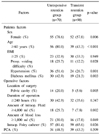Abstract
Purpose
We performed this study to investigate the predictive factors that are related to recovery from acute urinary retention after non-urogenital surgery.
Materials and Methods
We retrospectively analyzed the records of 160 patients who were referred to the department of urology because of lasting acute urinary retention after non-urogenital surgery at our institution between January 2004 and December 2006. Patients were divided into two groups: a transient retention group, which included patients who recovered voiding capability after urinary catheterization for 7 days, and the unresponsive retention group, which included patients who did not recover voiding capability. Surgical factors, patient factors, use of patient-controlled analgesia (PCA), amount of residual urine, and medications during catheterization were analyzed.
Results
In the chi-square analysis, gender (female, p=0.006), age (≥60 years old, p<0.001), preoperative voiding difficulty (p=0.028), comorbidity with hypertension (p=0.001), diabetes mellitus (p=0.003), location of surgery (pelvic cavity, p=0.005), amount of intraoperative fluid (≥4,000 ml, p=0.002), and intraoperative indwelling of Foley catheter (p=0.026) were found to differ significantly between the two groups. In the multivariate logistic regression analysis, gender (female, p=0.002; OR=5.6), age (≥60 years old, p=0.001; OR=5.9), hypertension (p=0.049; OR=2.6), location of surgery (pelvic cavity, p<0.001; OR=20.125), and amount of intraoperative fluid (≥4,000 ml, p=0.001; OR=8.5) were found to increase the risk of unresponsive urinary retention. The residual urine volume of the unresponsive urinary retention group was larger than that of the transient urinary retention group (741±306 ml vs. 614±222 ml, p=0.003).
Conclusions
Use of a preoperative indwelling catheter and careful management of urination is necessary to prevent unresponsive urinary retention in patients with risk factors such as female gender, old age, hypertension, surgery in the pelvic cavity, and a large amount of intraoperative fluid injection.
Figures and Tables
References
1. Wein AJ. Wein AJ, Kavoussi LR, Novick AC, Partin AW, Peters CA, editors. Lower urinary tract dysfunction in neurologic injury and disease. Campbell's urology. 2007. 9th ed. Philadelphia: Saunders;2040–2041.
2. Mayo ME, Lloyd-Davies RW, Shuttleworth KE, Tighe JR. The damaged human detrusor: functional and electron microscopic changes in disease. Br J Urol. 1973. 45:116–125.
3. Hinman F. Postoperative overdistention of the bladder. Surg Gynecol Obstet. 1976. 142:901–902.
4. Rosenstein D, McAninch JW. Urologic emergencies. Med Clin North Am. 2004. 88:495–518.
5. Lee SJ, Kim YT, Lee TY, Woo YN. Analysis of risk factors for acute urinary retention after non-urogenital surgery. Korean J Urol. 2007. 48:1277–1284.
6. Tammela T, Arjamaa O. Comparison of long-term and short-term stretch on rat urinary bladder in vitro. Urol Res. 1988. 16:277–280.
7. Matsumoto S, Hanai T, Shimizu N, Uemura H. Changes in smooth muscle cell phenotype and contractile function following ischemia-reperfusion injury in the rat urinary bladder. Hinyokika Kiyo. 2008. 54:179–184.
8. Bratslavsky G, Kogen BA, Matsumoto S, Aslan AR, Levin RM. Reperfusion injury of the rat bladder is worse than ischemia. J Urol. 2003. 170:2086–2090.
9. Wren KR, Wren TL. Postsurgical urinary retention. Urol Nurs. 1996. 16:45–47.
10. Hammarsten J, Hogstedt B. Hyperinsulinaemia as a risk factor for developing benign prostatic hyperplasia. Eur Urol. 2001. 39:151–158.
11. Expert Panel on Detection, Evaluation, and Treatment of High Blood Cholesterol in Adults. Executive summary of the third report of the national cholesterol education program (NCEP) expert panel on detection, evaluation, and treatment of high blood cholesterol in adults (adult treatment panel III). JAMA. 2001. 285:2486–2497.
12. Michel MC, Mehlburger L, Schumacher H, Bressel HU, Goepel M. Effect of diabetes on lower urinary tract symptoms in patients with benign prostatic hyperplasia. J Urol. 2000. 163:1725–1729.
13. Lee WC, Wu HP, Tai TY, Liu SP, Chen J, Yu HJ. Effects of diabetes on female voiding behavior. J Urol. 2004. 172:989–992.
14. Petros JG, Alameddine F, Testa E, Rimm EB, Robillard RJ. Patient-controlled analgesia and postoperative urinary retention after hysterectomy for benign disease. J Am Coll Surg. 1994. 176:663–667.
15. Petros JG, Rimm EB, Robillard RJ. Factors influencing urinary tract retention after elective open cholecystectomy. Surg Gynecol Obstet. 1992. 174:497–500.
16. Stallard S, Prescott S. Postoperative urinary retention in general surgical patients. Br J Surg. 1988. 75:1141–1143.
17. Bross S, Schumacher S, Scheepe JR, Zendler S, Braun PM, Alken P, et al. Effects of acute urinary bladder overdistension on bladder response during sacral neurostimulation. Eur Urol. 1999. 36:354–359.
18. Michelson JD, Lotke PA, Steinberg ME. Urinary-bladder management after total joint-replacement surgery. N Engl J Med. 1988. 319:321–326.
19. Carpiniello VL, Cendron M, Altman HG, Malloy TR, Booth R. Treatment of urinary complications after total joint replacement in elderly females. Urology. 1988. 32:186–188.
20. Kwon MI, Kim KM, Kim KW, Kim BK, Kim SY, Kim SD, et al. Anesthesiology. 2005. 3rd ed. Seoul: Ryomoongak;119–122.
21. Lanz E, Theiss D, Riess W, Sommer U. Epidural morphine for postoperative analgesia: a double-blind study. Anesth Analg. 1982. 61:236–240.
22. Husted S, Djurhuus JC, Husegaard HC, Jepsen J, Mortensen J. Effect of postoperative extradural morphine on lower urinary tract function. Acta Anaesthesiol Scand. 1985. 29:183–185.
23. Lasanen LT, Tammela TL, Kallioinen M, Waris T. Effect of acute distension on cholinergic innervation of the rat urinary bladder. Urol Res. 1992. 20:59–62.
24. Radomski SB, Herschorn S, Naglie G. Acute urinary retention in men: a comparison of voiding and nonvoiding patients after prostatectomy. J Urol. 1995. 153:685–688.
25. Caine M, Raz S, Zeigler M. Adrenergic and cholinergic receptors in the human prostate, prostatic capsule and bladder neck. Br J Urol. 1975. 47:193–202.
26. McNeill SA, Daruwala PD, Mitchell ID, Shearer MG, Hargreave TB. Sustained-release alfuzosin and trial without catheter after acute urinary retention: a prospective, placebo-controlled trial. BJU Int. 1999. 84:622–627.
27. Alan McNeill S. The role of alpha-blockers in the management of acute urinary retention caused by benign prostatic obstruction. Eur Urol. 2004. 45:325–332.




 PDF
PDF ePub
ePub Citation
Citation Print
Print





 XML Download
XML Download